#estonian parliamentary election 2015
Explore tagged Tumblr posts
Text
Estonian Parliamentary Elections 2019
Election system
Cycle: every 4 years
Voting system: Party-list proportional representation
Apportionment method: Modified D'Hondt method (slightly favours larger parties)
Total number of seats: 101
Electoral threshold: 5%
Summary:
Estonia has a multi-party system, with a coalition involving two or more parties. This year, 10 out of 14 parties will take part, with 5-6 expected to enter parliament.
Elections:
From 21-27.02, people could pre-vote or vote online. 28.1% of the eligible population voted online and 11.2% pre-voted (19.6% and 13.4% in 2015, respectively). The turnout for 2019 is estimated at around 65%, meaning that only about 26% of the eligible population will vote on the election day (down from 31%).
The results will likely be released from 20:00 to 00:00 EET, but the first results (pre-vote and internet vote) might not fully reflect the final results as Centre Party and EKRE are unsure about online voting.
Explanation of the electoral system and the appointment of seats
23 notes
·
View notes
Photo
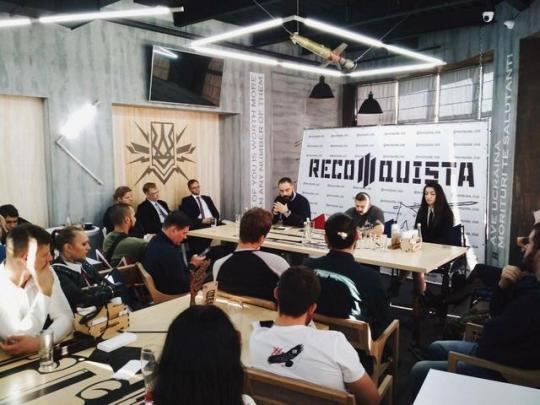
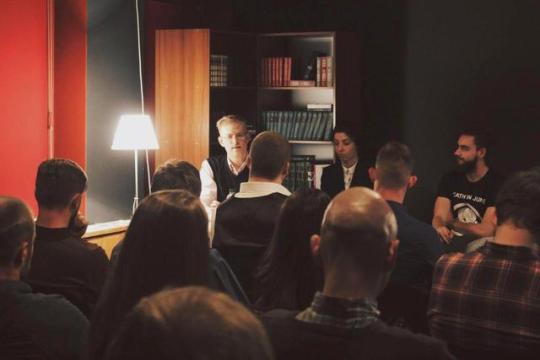

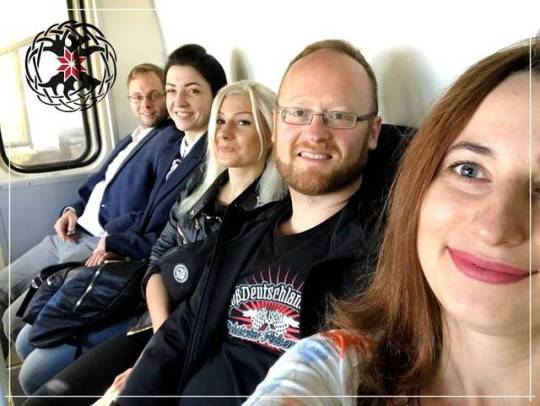
The Azov Movement in the West: achievements in 2019
Despite the fact that the official agenda of National Corps is a course towards Intermarium (Adriatic-Baltic-Black Sea Union), the years 2018 and 2019 were marked not only by regional events of the Intermarium Support Group, founded by Andriy Biletsky, Leader of National Corps, but also by popularization of our project in Western Europe and establishing of cooperation with both friendly Western European parties and those influenced by pro-Russian lobbyists. Along with it, we find sympathizers of Central and Eastern European Union among political forces and media platforms of the United States.
Having engaged in our activities, we adhere not only to the principle of paneuropeanism and alternative universalism, which shall prevent us from regional isolationism in the 21st century. Nor solely to the possibility (yet remote possibility) of the alternative of the EU all-European integration based on Central and Eastern Europe in case of growing animosity and decentralization of Europe.
It is a high time to admit that pro-Russian threat in Europe is tied not only with right-wing populists and “radicals”. After all, such influential right-populist parties like Polish PiS (Law and Justice) and Estonian EKRE (Estonian Conservative People’s Party), which lined up a fifth of seats on parliamentary elections, assume anti-Kremlin geopolitical attitude. Furthermore, namely these parties: both EKRE or Latvian coalition party “National Alliance” – are actual and potential Intermarium Support Group partners.
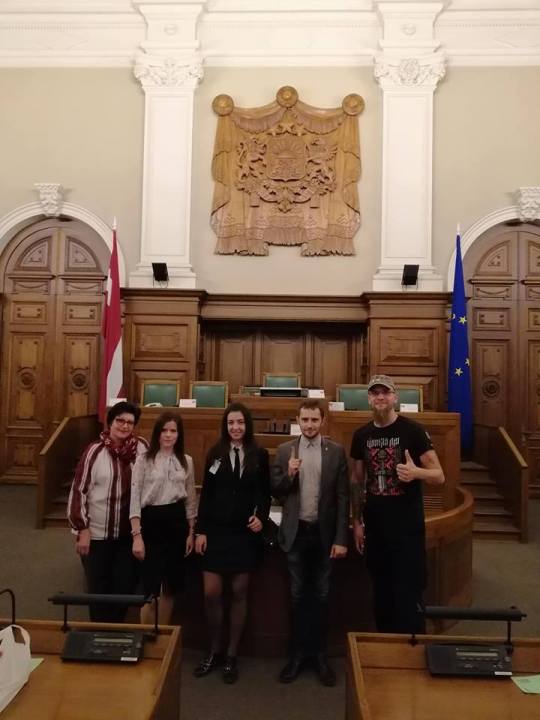
The problem is of another kind: not only a potentially pro-Russian coalition gathers in the European Parliament around the Italian Lega and German AfD – official Berlin, an economic leader of the EU, gradually weakens its resistance against Nord Stream 2, the pipeline which shall be built in circumvention of Ukrainian territory and rests on not only Russian and German but also Austrian, Danish and French funds. Following its own interests, neoliberal European Union persuades Ukraine to “conciliate” with the Russian Federation, which, in its turn, contradicts the interests of the US and some Central and Eastern European Countries only – again, “right-populist”.

Under such conditions, it is important to prevent the Intermarium Support Group’s activites from deceleration, especially in the light of electoral success of the Finns Party, The Swedish Democrats, Danish People’s Party and other parliamentary forces of the region, which are currently either in the danger zone, or already cooperating with pro-Russian anti-immigration colleagues from Western Europe. Furthermore, given the lack of political unity among such parties, it is worth to give a due time alternative for those willing to think strategically and to avoid the fate of Putin’s fan club.
However, it is no less important to multiply our informational presence in Western European and American informational field via cooperation with “pro-Ukrainian” organizations and even their separate structures.
The starting point of informational expansion of the Azov Movement in the Western European field shall be considered to the Paneuropa Conference, which took place 28 April 2017 in Kyiv under the auspices of all-European Reconquista movement founded in 2015 on the back of mass foreign volunteer support in the National Liberation War in the East of Ukraine. This conference, dedicated to the idea of the alternative to European integration and geopolitical cooperation, gathered representatives of French, Italian, German, Swedish, Croatian, Polish, Lithuanian, Latvian and Russian emigrational political forces supporting a persistent course towards the creation of a sovereign Paneuropean confederation.
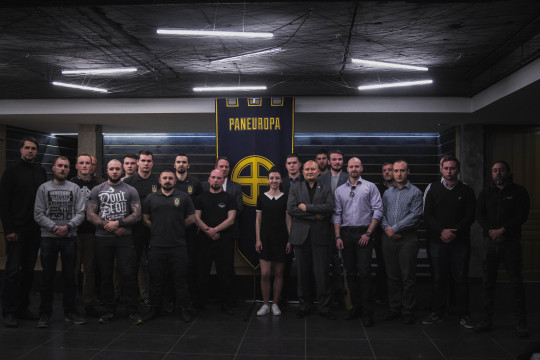
On October 15, 2018, the second Paneuropean conference was held in Kyiv, which was visited by local political forces, but also by speakers from Italy, Germany, Norway, Sweden, and the US. Similarly to the constituent conference, it included both the political, party element and the metapolitical component represented by Western intellectuals and bloggers associated with the Third Way, identitarian movement, French New Right (Nouvelle Droite) and American Alt-Right. Both conferences have gathered such prominent Western pro-Intermarium metapolitical thinkers like Gabriele Adinolfi, Pascal Lassalle, Marcus Follin (The Golden One), and Greg Johnson.

Active expansion of the Azov Movement into Western geopolitical and metapolitical sphere has begun with the participation of its representatives Victoria Polunina and Olena Semenyaka in the paneuropean congress named REGeneration Europa, which was organized on May 11-12, 2018, in the German town of Riesa by a youth branch of NPD, Junge Nationalisten. Though a marginal pro-LDNR Russian group was also represented at the conference, which provoked the pro-Ukrainian wing, it was the first mass Western European event marking the start of the further Azov “tour” across Western Europe on the invitations from the interested in the prospects of our cooperation.
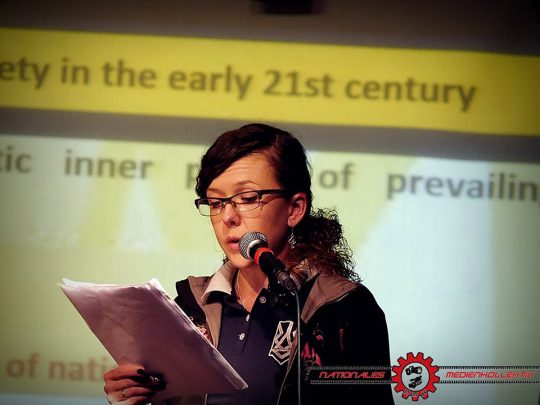
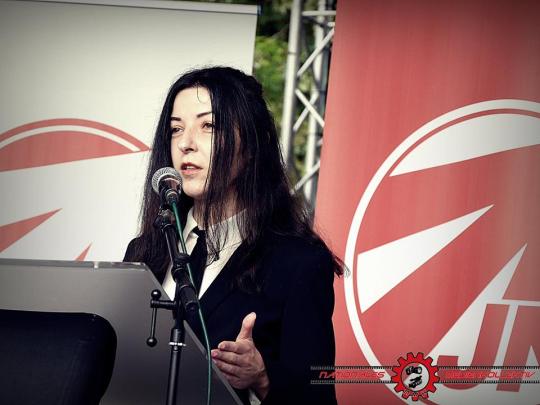
Next year, in spite of a fact that the NPD party has a split on the question of a military and geopolitical conflict between Ukraine and Russia, its youth branch took part in the second Paneuropa Conference in Kyiv and already on February 15-16, 2019 international secretary of National Corps Olena Semenyaka accepted the invitation of the NPD in Saxon Switzerland and the metapolitical center Haus Montag to speak at the event in Pirna in the course of which she described the history of the Azov Movement, the next day after the march in memory of victims of Dresden bombardment.
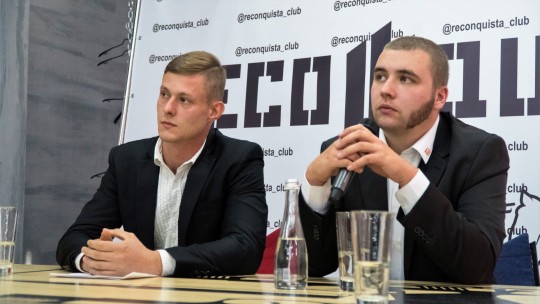
Among all described projects of the Azov Movement, the most challenging, but promising one is the geopolitical program of National Corps: Intermarium defense union as a platform for the alternative to the EU sovereign Paneuropean union. The false rivalry of the West and the Russian Federation creates the unique chance for the intended “buffer zone,” Eastern Europe, to become the center of the restoration of the all-European geopolitical subjectivity.
Moreover, this event was the first in the cycle of events within the framework of the «Ukrainian Year» in Germany, on the initiative of Thomas Rackow, the author of the charity German-Ukrainian-Norwegian Kraftquell (Source of Power) project aimed at organizing the vacation for veteran Ukrainian families in Germany and Norway as a sign of the solidarity of the European family with the belligerent Ukraine. He announced this project during the Paneuropa Conference II in Kyiv and on completion of the speech by Olena Semenyaka in Pirna.

In addition, namely on his initiative, Olena visited the annual convention of autonomous Norwegian nationalists in Eastern Norway who were interested in the geopolitical program of National Corps and supported the Kraftquell project.

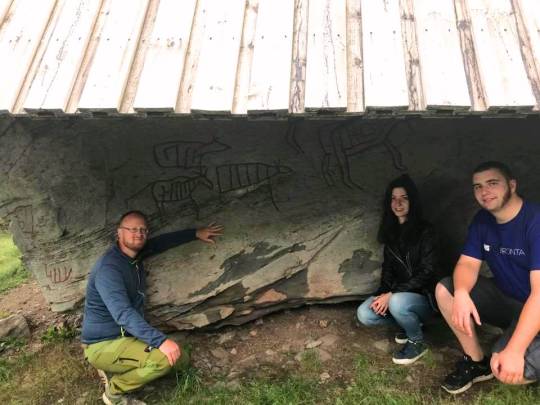
In June 2018, Olena Semenyaka also delivered a speech to the audience of Flamberg Club, the identitarian metapolitical center in Halle, within the framework of an event entitled “Ukrainian Evening: geopolitics, ideas, prospects”. She revealed the basis of Ukrainian state building, identity, the conflict with Russia, history and structure of the Azov Movement and the geopolitical project of Intermarium.
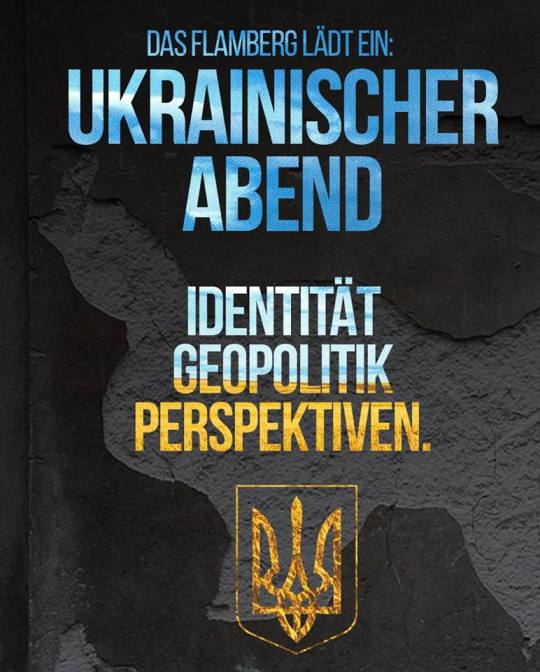
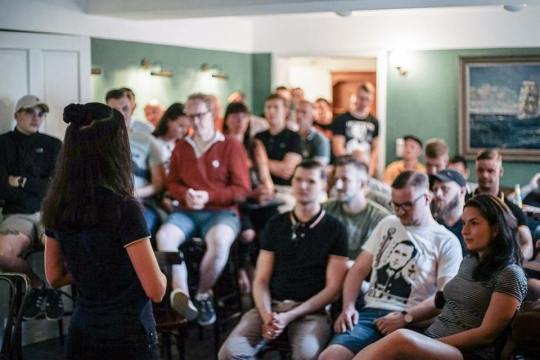
As soon as 3-5 of August 2018, Olena Semenyaka also delivered a lecture at the first Jungeuropa Forum organized in Dresden by Jungeuropa Verlag, the friendly publishing house of identitarian Third Way literature. Olena described to German and Austrian identitarians the geopolitical, cultural and philosophical foundations of Intermarium.
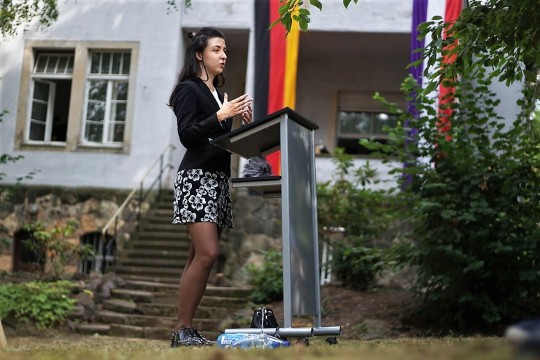
June 7, 2018, Olena Semenyaka revealed the metapolitical strategies of the Azov Movement at the cultural and political event entitled “The Youth Storms” in Kirchheim, Thuringia on the invitation of the German party Der III. Weg (Third Way), a long-time ally of the Azov Movement, the first ones who united with the German branch of the Reconquista Movement in their efforts to destroy the information blockade around the fight of Ukrainian patriots.
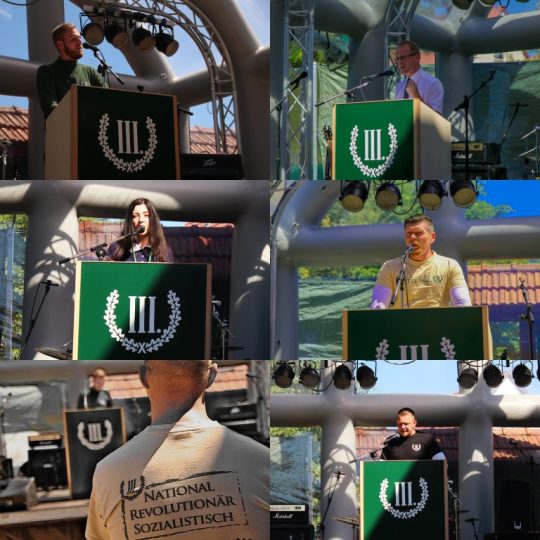
In the wake of the Third Conference of the Intermarium Support Group in October 13, 2018, which, among others, was attended by the representative of the Academic Legion Project of the Ministry of National Defense of Poland Damian Duda and Croatian Armed Force General Brigadier Bruno Zorica, right on February 15-16, 2019, Eugene Vriadnyk, combat veteran of the Azov Regiment, founder of Plomin publishing house, delivered a speech on his vision of archeofuturistic future of Central and Eastern Europe at the Prabudimas Conference in Vilnius, as well as took part in a torchlight procession in honor of the anniversary of Lithuania’s independence, which were organized by the Kryptis ethnofuturist association.

January 7, 2019, Olena Semenyaka participated in the commemoration of three young Italian patriots killed by communists in Acca Larentia massacre. The march, dedicated to the bloody event of the Lead 70-s, has become an all-Italian sacral rite precisely thanks to the activity of Casa Pound Italia. This organization has also brought this event even to the all-European and transcontinental level, gathering participants as far as from Quebec. This visit has strengthened the partnership with CasaPound Italia represented by their international correspondent Alberto Palladino at the Second Paneuropa Conference in Kyiv.
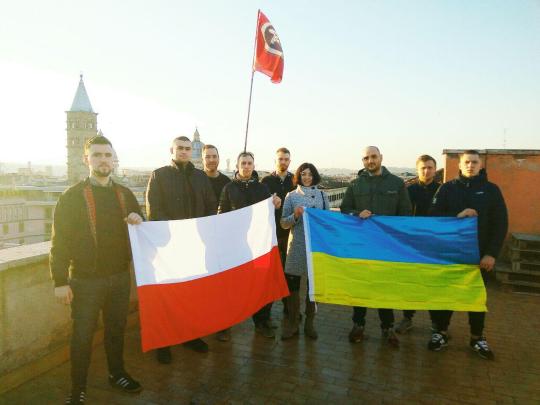

Besides, National Corps has been a participant of the Third Etnofutur Conference, which took place on the 23rd of February in Tallinn. This event is held annually by the youth organization of Estonian People’s Conservative Party (EKRE), Blue Awakening (Sinine Äratus). Traditionally, the strong emphasis has been laid on the conceptual synergy of the nationalist speakers of the Intermarium region. Olena Semenyaka has delivered a speech entitled “Middle Europe in the Age of Caesarism and the Purpose of Ethnofuturism”. In her speech, she mentioned that namely the Azov Movement is the brightest example of Ethnofuturism as a combination of innovative technologies with the policy of protecting ethnocultural identities.

Having referred to Oswald Spengler’s concept of Caesarism as the final period of the historic cycle of the West which began with the first world war, Olena presented Intermarium as space where Old Europe can return to life again entering a new cultural and civilizational turn.
In addition, National Corps sent his representative to support EKRE ahead of parliamentary elections. Fortunately, the allied party showed an exceptionally high result. On February 24, Olena, also traditionally, participated the celebration of the independence of Estonia and anniversary torchlight parade.
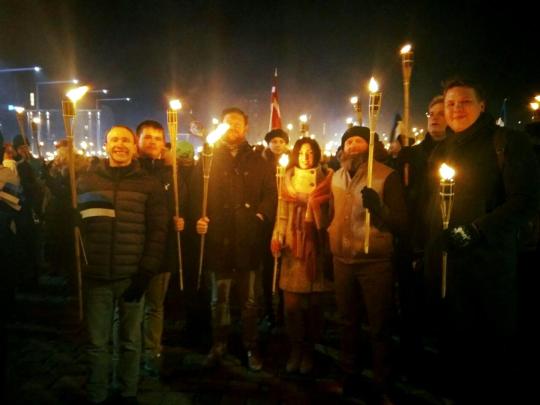
On March 30, 2019, Olena Semenyaka spoke at the Pan-Scandinavian Scandza Forum founded by Fróði Midjord. The forum addressed the problems of the lacking freedom and imported chaos in modern Western societies (”Anarcho-Tyranny”). Having investigated the issue in the context of Ernst Jünger’s criticism of neo-totalitarian police state, as well as the need to put modern audiovisual technologies into service of our own historical visions, she called the region of Central and Eastern Europe the space of political freedom where it would be possible to develop the paneuropean infrastructure for such purposes. The event was also attended by members of Swedish Democrats and Alternative for Sweden.
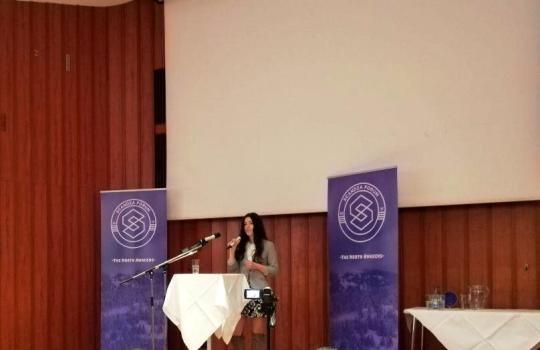
After the Scandza Forum, Olena Semenyaka became the guest of the “Anton och Jonas” video program during which she discussed the course of the Maidan Revolution, the reasons for the geopolitical confrontation with Russia, the milestones of the formation of the Azov Movement and the Intermarium project. Her interlocutors were Anton Stigermark, the representative of the Alternative for Sweden party, the author of the “Memetic Warfare”, who also participated in the MMA tournament at the Kyiv Reconquista Club, and Jonas Nilsson, coordinator of the Boer Project, also the MMA enthusiast and a former instructor of the Azov regiment, which hosted a lot of Swedish military volunteers.
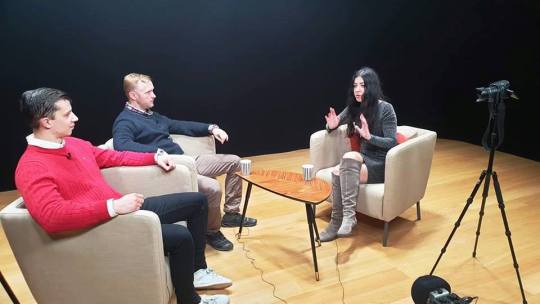
Finally, on April 6, 2019, the National Corps, represented by the international secretary and coordinator of the Intermarium project Olena Semenyaka, took part in the Awakening II Сonference in the Finnish city of Turku. At this conference, Olena made a presentation "Finnish-Ukrainian Cooperation Then and Now As Seen by National Corps” during which she discussed the diplomatic cooperation of Finland with the Hetmanate and the UPR in the previous century, in particular, thanks to the ardent Finnish advocate of the Ukrainian national liberation movement Hermann Gummerus, as well today’s step-by-step integration program of the Intermarium Support Group.
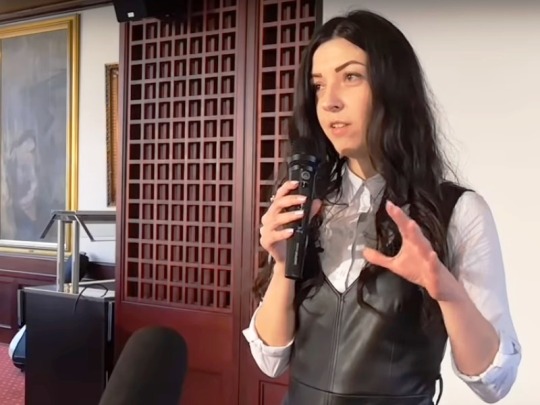
In addition to foreign speakers and guests, the event was visited by members of the Finnish identitarian organization Suomen Sisu and the youth branch of the Finns Party. Finnish audience, which had its own experience of Russian-Finnish wars, was fascinated by the natural geopolitical vector towards Intermarium. It is worth to mention that the Finns Party has lined up 39 parliamentary seats out of 200 during the recent election.
It is planned that Olena Semenyaka will take part in Forum Prisma Actual on May 4, 2019, in Lisbon, on the invitation of Escudo Idetitario, Portuguese identitarian organization. Along with developed Spanish branch of the paneuropean Reconquista movement, Portuguese patriots couldn`t help resonating with the cause of the novel Ukrainian “conquistadors.”

Among the Southern European countries, the great interest in Azov’s activity is shared by Greece whose patriotic audience also feels the cultural and geoeconomic affinity towards the project of Intermarium and invite National Corps to their land.
However, the priority of the Intermarium Support Group for the second half of 2019, of course, is holding the Fourth International Conference bringing the regional European integration to the new level. According to preliminary plans, the conference will be held in Zagreb, a center of the Adriatic angle of Intermarium.
#National Corps#AZOV movement#Andriy Biletsky#Intermarium Support Group#Olena Semenyaka#eugene vriadnyk#Paneuropa#reconquista movement
4 notes
·
View notes
Text
Fun Fact 179
Estonia has an incredibly advanced system of online government where citizens can carry out most of their interactions with government online including proposing bills, starting a business and even vote in elections. Estonians can use their special ID-cards to vote from anywhere in the world and in parliamentary elections in 2015, 30.5% of votes were cast online and were received from 116 countries.
#politics#politics fun facts#fun facts#facts#politics facts#amazing#amazing facts#interesting#interesting facts#did you know#world#travel#international relations#international politics#estonia#europe#government#elections#egovernment#internet#technology#business#economics#innovation#vote#online#democracy
286 notes
·
View notes
Text
Lessons For The World On How Estonia’s Digital State Is Coping With Coronavirus
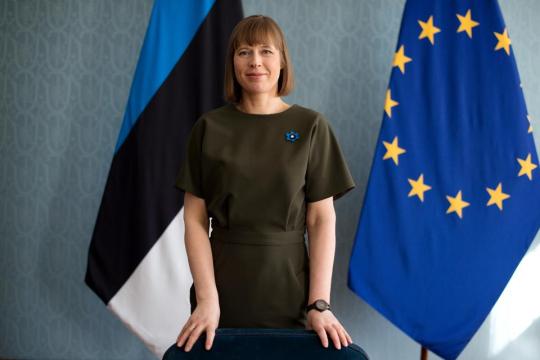
Kersti Kaljulaid, Estonia’s president. Photographer: Peti Kollanyi/Bloomberg
© 2017 Bloomberg Finance LP
“Its government is virtual, borderless, blockchained, and secure. Has this tiny post-Soviet nation found the way of the future?” So asked The New Yorker in the standfirst of its 2017 article on Estonia, the Digital Republic. If the way Estonia is governed is new to you, after reading the 7,500 or so words of Nathan Heller’s article you’ll likely conclude that it is, indeed, the future. If the digital republic isn’t new to you, you’ve very likely already concluded it is.
Coronavirus is shaking the world out of all sorts of complacencies. Governments’ capacity – or lack of it – is suddenly under the microscope, which is making the case for digital government reforms in the image of Estonia not just attractive, which they have always been, but vital.
Like all countries, Estonia is suffering. It is facing the same immediate threat as many other countries and in response is isolating itself and its inhabitants from the virus, including, most dramatically, Saaremaa, a small island off its coast, where a high percentage of the population are thought to have contracted the virus. (A volleyball tournament on 4th and 5th March involving Power Volley Milano seems to be the reason the island’s 33,000 people have been so hard hit.)
I’ve written before on why Estonia’s digital state shows the way for government reforms in the U.K. My call for these radical reforms was more in hope than expectation. There is a great deal of inertia within any government, and the U.K. doesn’t have the magic mix that made Estonia’s reforms possible; namely, a blank slate for a young set of reform-minded officials on tight budget, finally free of Soviet occupation and on a mission to improve the lives of its citizens.
I’m not the first person to take a look at how Estonia is reacting to the crisis. The New Yorker (again) makes the case for why Estonia was poised to handle how a pandemic would change everything: “Its economy is bound to tech, its government is digital, and most services in the country either are or can be provided electronically – in fact, it’s nearly impossible to overstate the extent of Estonian digitization. People vote online and use digital prescriptions; a single piece of I.D. securely stores each Estonian’s personal information, including health, tax, and police records; one can even establish residency and begin paying taxes in the country digitally—effectively immigrating online.”
It’s a good article, but it doesn’t get into the nitty gritty of how a digital state is making a practical difference to the lives of its citizens at this most challenging time.
Hack the Crisis
The most newsworthy reaction to coronavirus was ‘Hack the Crisis.’ Perhaps hackathons are a little passé, but it has been effective.
Ideas included “a platform for connecting vulnerable, at-risk people with volunteers via a call center; an online tutoring service for school children in quarantine; an add-on to smartwatches to help people check for coronavirus symptoms; an online display of what food stocks are available in local supermarkets; and an app to map the spread of coronavirus, which invites people to self-report cases.”
Suve was also created at the event organized by Garage48 and Accelerate Estonia. She is a chatbot that’s able to answer citizens’ questions related to the crisis situation and she’s already been rolled out across government websites. Share Force One was also created in the hack. It’s a workforce sharing platform that connects B2B sides for temporary workforce exchange and is being run in partnership with Estonian Unemployment Insurance Fund.
Next up, Estonia is “teaming up with Mistletoe Singapore, the European Commission and other local and international supporters, to organize a 100-hour free online accelerator for startups with potential to have a strong impact on shaping today’s and the post-crisis world.” Salto Growth Camp: EMERGEncy includes the Estonian President, Kersti Kaljulaid, as a mentor, as well as founders from Bolt, Skype, Pipedrive, Veriff, Testlio and other Estonian high-growth startups and scaleups.
This is What State Capacity Looks Like
Hackathons and accelerators are all well and good, but they’re just the tip of the iceberg. The thing that really sets Estonia apart from countries like the U.K. in dealing with coronavirus isn’t so easily replicable.
First, a note of caution though. The economic fallout will be severe for every country in the world and Estonia is as reliant on global supply chains as any country, whether in purchasing their Personal Protective Equipment (PPE), ventilators, or, presumably, the vaccine, when it finally comes. And Estonia, like many countries – though worryingly not the U.K., which is opting for a centralized approach – is planning to integrate its contact tracing app with Apple and Google’s joint COVID-19 tracing tool for iOS and Android.
Priit Tohver Advisor for Digital Services Innovation in the Ministry of Social Affairs, explains: “In Estonia we are indebted to all the hard work that has already been put into developing contact tracing apps around the world. It is clear, however, that without integrating with the Apple and Google API, these solutions will never achieve their full potential. Fortunately the approach supported by the API aligns well with our privacy-preserving principles.”
Privacy and security are front and center to the Estonia model, which ironically has been the most common objection to their digital reforms from many in other countries over the years. The criticism tends to be civil liberties objection to having ID cards, although they are no longer necessary because digital apps have effectively replaced the need for a physical card. Nevertheless, central to a capable state is the need for everyone in the country to have a digital identity, but this is infinitely more secure than the hodgepodge approach that countries like the UK take to managing and securing data. In Estonia, where and how data is collected, stored and deleted is central to every interaction and process, as well as who can access it and when.
E-Government in the Time of Coronavirus
State capacity requires a functioning government. That is proving tricky for many countries who have only ever done it in physical parliaments. Estonia has been doing e-Cabinet since the early 2000s, with government business easily conducted securely online. And while the postponement of English local elections for a year is the right decision in the circumstances, this wouldn’t have been necessary in Estonia, where i-Voting has been possible since 2005. At the last parliamentary elections in March 2019, 44% of Estonians voted online.
While i-Voting is much cheaper (€2.32 versus €20.41 per vote), the move has always struck me as something that shouldn’t be decided by just value for money. Most obviously because of the added trust people have in a system where other citizens physically count the votes, but also because of the pleasure people get from the ritual of visiting the polling booth with others. Nevertheless, coronavirus has revealed the value of at least having a backup system in place to keep democracy functioning even when we can’t easily leave the house.
Estonians have been using digital signatures in their interactions with the government since 2002. While countries like the U.K. are being forced to try to move to interactions online, Estonians are afforded a higher level of security by way of their digital identity card through the physical smart card reader, or increasingly directly through their computer and phone through apps. (Incidentally, the card can also be used as a way of confirming your identity directly with the private sector where you need to prove your identity, such as for loyalty schemes.)
Back in 2015, Estonia planned to digitalize all educational materials by 2020, which is why they were ready to swiftly launch Education Nation with Finland, Denmark, Iceland, Latvia, Lithuania, Norway and Sweden, and make the switch to teaching and learning fully online. They have also made the resources available for free to the rest of the world.
As reported from Germany: “Teacher training in e-learning started around 10 years ago, according to the country′s deputy education minister, Marts Laidmets. Estonian educators also have access to a wide array of online tools to connect pupils, teachers and parents. Those include eKool, a school management network that has more than 200,000 active users on a normal day, and Stuudium, a suite of apps with educational materials, assessment tools and messaging. Much of Estonian schooling is already in the cloud, and 87% of schools use tools like eKool and Stuudium, whether for lesson plans, homework, absence management or recording grades.”
Estonia was also ready to keep the wheels of justice turning post-lockdown. It’s e-Justice system ensures court proceedings are both one of the cheapest to run and one of the fastest in Europe.
Here is how it works: “As soon as a citizen has securely authenticated themselves and accessed the e-justice platform, they can submit any kind of cases online. The data will be shared between institutions that are linked to the case and courts can start proceeding related documents. These interactions are based on the once-only policy which means that duplicates of information are not allowed in state databases.”
“The e-file platform also allows courts to send citizens different documents, while notifications ensure judges that all files have been successfully delivered. Every document is timestamped and contains a secure electronic signature. Furthermore, classified information can be encrypted by the courts to make sure that no third party would be able to access the data.”
While other countries are struggling to get court systems online (and even throwing people in jail for not paying their parking fines without a functioning court system), Estonia is already using AI to solve simple disputes of small claims disputes of less than €7,000.
In a recent interview, the potential for a digital state was set out by Indrek Õnnik, Global Affairs Director at Government CIO Office, on how Estonia is dealing with coronavirus. The Estonian Police and Border Guard Board sends you a message via your virtual personal assistant to inform you that your passport is expiring in 6 months. In response, you might decide to book an appointment for five months through your virtual assistant, but the personal assistant immediately alerts you that you’ll need a passport with more than 6 months’ left on it because you’ve booked a trip to Thailand that requires it. The personal assistant then applies for the passport straight away and a phone notification prompts you to take a photo on your smartphone. You take the photo, but the AI has identified that you’ve smiled in it and prompts you to take another one. You do and your passport arrives in 5 days.
In the same interview, he also posits a future scenario where the borders have to close again but you’re stuck in another country. Rather than panic, you alert the embassy online through your smartphone, which automatically organizes the safest and most efficient way for you to get home. This is Estonian’s vision of the near future.
It’s perhaps in healthcare and welfare where the weaknesses of government systems feel most acute right now. In the U.K., for example, the gaps in support aren’t being filled because of a lack of adequate data – particularly for some self-employed and company directors who’ve paid themselves in dividends. It’s not a lack of present will, but a lack of state capacity.
In terms of welfare, Estonia’s automated and (relatively) accurate registries automatically share information so people get what they’re entitled to. As President of Estonia Kersti Kaljulaid explains in a recent HBR podcast, unlike in many other countries, Estonian citizens who were sick with coronavirus didn’t have to report to anyone physically, which avoided it spreading that way as it did in the early stages in some countries that weren’t on top of this straight away. Instead, people were away able to immediately apply for social security online.
Digitalization, privacy and data protection are baked into the health system. Estonia already has digital prescriptions and patient files are digitized, so doctors have access to all relevant health records, including from specialists. This means that they’re better able to identify those who are at risk from coronavirus than in countries where information is siloed and reliant on paper trails.
Towards a Digital State
Estonia’s digital state would not exist without an equally competent private sector, but that’s not the blockage in countries like the U.K. As President Kaljulaid in the HBR podcast says of the remarkable efficiency of the state: “We didn’t know that the public sector was supposed to be falling behind.”
So, what next? President Kaljulaid believes, I think correctly, that the current situation will speed up the need for reforms rather than overthrow the established order: “It’s more an accelerator than a total game-changer, because all these measures that we need to take: vaccinations, social distancing, more services online which allows you social distancing, wearing protective masks, for example, on public transport. These are all things that we had before. We simply did not apply them. Nothing has emerged, which would say the world will be totally different.”
The Estonian government isn’t perfect. For example, it lags countries like the UK on innovations like Open Data which lets companies build services on the back of government data without the need for government involvement. But we could and should want to excel at both, and this pandemic has thrown into sharp relief why governments across the world need a digital upgrade.
To (probably) quote sci-fi writer William Gibson: “The future has arrived — it’s just not evenly distributed yet.“
Source link
Tags: Coping, coronavirus, Digital, Estonias, Lessons, state, World
from WordPress https://ift.tt/3aPrG32 via IFTTT
0 notes
Text
Far Right Gains in Estonia Eyed for Clues to EU-wide Vote
Tiny Estonia has become the latest European country with a political landscape reshaped by a populist party promising national survival in an age of globalism, a development noted Monday in light of European Union parliament elections. Political observers watched a parliamentary election held Sunday in the Baltic nation, an EU and NATO member that borders Russia, as a continental barometer for whether far-right nationalists would continue making gains. And in Estonia, they did. While the center-right Reform Party, which ran on a low-tax, small-government platform, will be tasked with forming a government, the anti-immigrant, euroskeptic Estonian Conservative People's Party more than doubled its seat tally in parliament. Reform Party leader Kaja Kallas is expected to become the country's first female prime minister after her party finished with 28.8 percent of the vote. The party said before the election it would not consider the Estonian Conservative People's Party, or EKRE, as a potential governing coalition partner. The far-right party nevertheless captured a larger platform for its positions, some of which critics see as homophobic and racist. Martin Helme, who runs EKRE with his father and leads its parliament caucus, has said publicly that only white immigrants should be allowed into Estonia. On election night, Helme said the party's growing popularity was “no different than almost all other countries in Europe, where there's a serious public demand for political parties who will stand up against the globalist agenda” and European Union policymakers. But the “biggest achievement” the vote count reflects is “We are dictating the Estonian political agenda,” he said. In recent years and months, support for populist parties with nationalist agendas has grown in Europe, from Poland and Hungary to France and Italy. The outcome in Estonia bore similarities to what happened in Sweden last year. The Sweden Democrats, a party with neo-Nazi roots, won 62 seats in the 349-member parliament on Sept. 9, making it the third-largest party. The other parties ruled out forming a coalition government that included the Sweden Democrats. It took four months before a two-party, center-left minority government took office. In some countries, including Italy, nationalist surges followed large influxes of immigrants. In others, like Poland and Estonia, mass migration has been a source of anxiety even though the number of arriving migrants has been extremely small. Shrinking populations and the threat of cultural identity eroding stirs the fear in countries that gained independence with the fall of the Soviet Union three decades ago. Estonia, a former Soviet republic, has just 1.3 million people and its population declines each year due to low birth rates and emigration to richer Western countries. Ethnic Estonians make up 70 percent of the population, or some 900,000 people. In explaining his party's success in the election, Martin Helme, 42, said its message promoting traditional values has appeal to voters when demographic changes are causing worries. “Emigration is a big thing in Estonia,” he said. “The replacement of the population in Estonia. Estonians are leaving and others coming in. These are big issues. Compared to those issues, tax issues are just meaningless.” EKRE was formed in 2012 through a merger of an agrarian and a populist party. It defines its ideology as nationalist-conservative and its goal to protect the benefits of ethnic Estonians. The party leads an annual torch-lit Independence Day march through Tallinn's Old Town. During the February event, hundreds of participants shout the party's slogan “For Estonia!” Martin Helme's father, party chairman Mart Helme, is a former diplomat and a historian specializing in ancient Estonian civilization. He took over as EKRE's leader in 2013 and led it to securing 8 percent of the vote, or seven parliament seats, in 2015. The party opposed Estonia becoming the first ex-Soviet republic to allow same-sex couples to register as civil partners. In the past, it called for a referendum on leaving the EU but did not gain traction with the idea. Martin Molder, a political scientist at Estonia's University of Tartu, thinks the party's growing strength is a protest against established elites. “There's a lot of generic dissatisfaction in the electorate in regards to how ‘business as usual’ is done in politics,” Molder said. “Certain parties and politicians have been in power for a long time and they’ve created a kind of class of professional politicians whose only experience in life has been doing politics.” from Blogger https://ift.tt/2H15xnM via IFTTT
0 notes
Text
Estonia’s political landscape reshaped by far-right party
TALLINN, Estonia — Tiny Estonia has become the latest European country with a political landscape reshaped by a populist party promising to be the bulwark for national survival in an age of globalism, a development noted Monday in light of European Union parliament elections.
Political observers watched a parliamentary election held Sunday in the Baltic nation, an EU and NATO member that borders Russia, as a continental barometer for whether far-right nationalists would continue making gains. And in Estonia, they did.
While the centre-right Reform Party, which ran on a low-tax, small-government platform, will be tasked with forming a government, the anti-immigrant and euroskeptic Estonian Conservative People’s Party more than doubled its seat tally in parliament.
Reform Party leader Kaja Kallas is expected to become the country’s first female prime minister after her party finished with 28.8 per cent of the vote. Her party said before the election it would not consider the Estonian Conservative People’s Party, or EKRE, as a potential governing coalition partner.
The far-right party nevertheless captured a larger platform for its positions, some of which critics see as homophobic and racist.
“We are dictating the Estonian political agenda,” Martin Helme, who runs EKRE with his father and leads its parliament caucus, declared after the ballot count was completed. “That’s our biggest achievement.”
He added: “I think Estonia is no different than almost all other countries in Europe, where there���s a serious public demand for political parties who will stand up against the globalist agenda and the ever-increasing movement of power from (EU) member states to Brussels.”
In recent years and months, support for populist parties with nationalist agendas has grown in Europe, from Poland and Hungary to France and Italy.
The outcome in Estonia bore similarities to what happened in Sweden last year. The Sweden Democrats, a party with neo-Nazi roots, won 62 seats in the 349-member parliament on Sept. 9, making it the third-largest party.
The other parties ruled out forming a coalition government that included the Sweden Democrats. It took four months before a two-party, centre-left minority government took office.
In some countries, including Italy, nationalist surges followed large influxes of immigrants. In others, like Poland and Estonia, mass migration has been a source of anxiety even though the number of arriving migrants has been extremely small.
Shrinking populations and the threat of cultural identity eroding stirs the fear in countries that gained independence with the fall of the Soviet Union three decades ago.
Estonia, a former Soviet republic, has just 1.3 million people and its population declines each year due to low birth rates and emigration to richer Western countries. Ethnic Estonians make up 70 per cent of the population, or some 900,000 people.
In explaining his party’s success in the election, Martin Helme, 42, said its message promoting traditional values has appeal to voters when demographic changes are causing worries.
“Emigration is a big thing in Estonia,” he said. “The replacement of the population in Estonia. Estonians are leaving and others coming in. These are big issues. Compared to those issues, tax issues are just meaningless.”
EKRE was formed in 2012 through a merger of an agrarian and a populist party. It defines its ideology as nationalist-conservative and its goal to protect the benefits of ethnic Estonians.
The party leads an annual torch-lit Independence Day march through Tallinn’s Old Town. During the February event, hundreds of participants shout the party’s slogan “For Estonia!”
Martin Helme’s father, party chairman Mart Helme, is a former diplomat and a historian specializing in ancient Estonian civilization. He took over as EKRE’s leader in 2013 and led it to securing 8 per cent of the vote, or seven parliament seats, in 2015.
The party has in the past called for a referendum on leaving the EU but so far got no traction with that idea in a country where support for EU membership is high.
Martin Molder, a political scientist at Estonia’s University of Tartu, thinks the party’s growing strength is a protest against established elites.
“There’s a lot of generic dissatisfaction in the electorate in regards to how ‘business as usual’ is done in politics,” Molder said. “Certain parties and politicians have been in power for a long time and they’ve created a kind of class of professional politicians whose only experience in life has been doing politics.
——
Jan M. Olsen contributed to this report from Copenhagen, Denmark.
from Financial Post https://ift.tt/2UjBvPp via IFTTT Blogger Mortgage Tumblr Mortgage Evernote Mortgage Wordpress Mortgage href="https://www.diigo.com/user/gelsi11">Diigo Mortgage
0 notes
Text
Jüri Ratas
Jüri Ratas (born 2 July 1978, in Tallinn) is an Estonian politician who is the current leader of the Centre Party and the Prime Minister of Estonia. He acted as the vice-president of the Riigikogu from 2007 to 2016 and Mayor of Tallinn from 2005 to 2007. As a mayor of Tallinn he initiated the European Green Capital programme.[1]
In the 2015 Estonian parliamentary election, Ratas was reelected to…
View On WordPress
0 notes
Photo

6 pack II
0 notes
Text
The Latest: Estonian opposition leader derides govt policies
TALLINN, Estonia — The Latest on Estonia’s general election (all times local):
1:50 p.m.
The leader of Estonia’s main opposition party has voted in the general election and accused Prime Minister Juri Ratas’ government of “messing up” the small Baltic nation’s taxation system.
Estonians are voting Sunday in a general election where the opposition centre-right Reform Party is challenging Ratas’ left-leaning Center Party with a focus on socio-economic issues, such as taxation.
Reform Party leader Kaja Kallas told The Associated Press while voting in central Tallinn that “the topic that most people talk about are the taxes” and that Ratas’ Cabinet “has totally messed (up) the tax system, excise duties, income tax system and people are really annoyed by this.”
Among other things, Ratas’ government has substantially increased excise duties on alcohol, partly on health grounds, and reformed Estonia’s flat income tax, a cornerstone of the economy. Estonia has one of the highest rates of alcohol-related deaths in Europe.
——
9 a.m.
Estonians have started voting in a parliamentary election in the small Baltic nation in a ballot where Prime Minister Juri Ratas and his Center Party are pitted against the centre-right opposition Reform Party and where populists are seen making inroads.
Sunday���s vote in the NATO and the European Union member of 1.3 million comes as the far-right, nationalist Estonian Conservative People’s Party, EKRE, has substantially increased its popularity since the 2015 election.
Both main contenders wish to keep it at bay.
Nearly a million voters are eligible to elect representatives for the next four years to the 101-seat Riigikogu legislature.
About 26 per cent have previously cast their votes online. Electronic voting pioneer Estonia was the first country in the world to use online balloting for a national election in 2005.
from Financial Post https://ift.tt/2J2advR via IFTTT Blogger Mortgage Tumblr Mortgage Evernote Mortgage Wordpress Mortgage href="https://www.diigo.com/user/gelsi11">Diigo Mortgage
0 notes
Text
Estonians head to polls with populist party seen rising
TALLINN, Estonia — Estonians have started voting in a parliamentary election in the small Baltic nation in a ballot where Prime Minister Juri Ratas and his Center Party are pitted against the centre-right opposition Reform Party and where populists are seen making inroads.
Sunday’s vote in the NATO and the European Union member of 1.3 million comes as the far-right, nationalist Estonian Conservative People’s Party, EKRE, has substantially increased its popularity since the 2015 election.
Both main contenders wish to keep it at bay.
Nearly a million voters are eligible to elect representatives for the next four years to the 101-seat Riigikogu legislature.
About 26 per cent have previously cast their votes online. Electronic voting pioneer Estonia was the first country in the world to use online balloting for a national election in 2005.
from Financial Post https://ift.tt/2Hc4HUz via IFTTT Blogger Mortgage Tumblr Mortgage Evernote Mortgage Wordpress Mortgage href="https://www.diigo.com/user/gelsi11">Diigo Mortgage
0 notes
Photo








Huey, Dewey & Louie. Coalition talks 2015, Estonia Illustrations for Feministeerium
0 notes
Photo



6 pack
2 notes
·
View notes